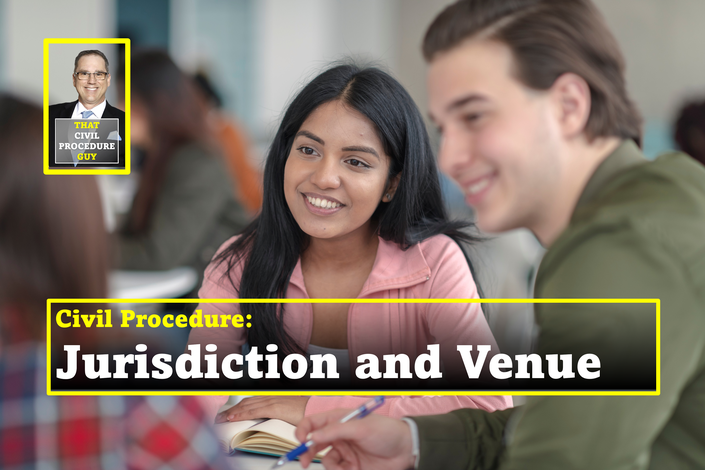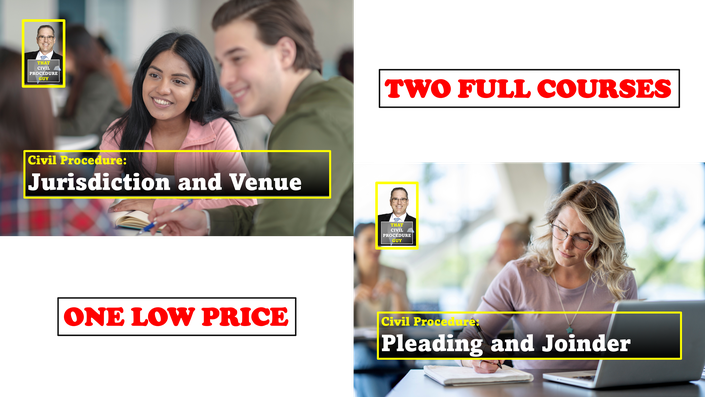
Your instructor
John T. Ritondo, Jr. Esq.
Professor of Law and Practicing Attorney
John T. Ritondo, Jr. is an accomplished attorney, educator, and legal professional based in Birmingham, Alabama. In the last 20 years he has educated a generation of law students as a Professor of Law at the Birmingham School of Law, where he has revolutionized legal education with innovative, case-based curricula in Civil Procedure. His contributions have significantly improved bar exam pass rates and earned him multiple awards, including being name "Outstanding Professor of Law" multiple times.
John’s past career spans notable roles, including serving as a Career Law Clerk for the United States District Court for the Northern District of Alabama, where he contributed to some of the court's highest efficiency and lowest appeal rates. He holds a Juris Doctor from Cumberland School of Law at Samford University and a Bachelor of Arts in Political Science from the University of Alabama.

About the Course
This course provides a deep, practical understanding of the Federal Rules of Civil Procedure as they relate to pleading and joinder—the building blocks of civil litigation. Whether you're a law student seeking clarity or a bar taker reinforcing the essentials, this course delivers structured, digestible lessons grounded in real-world application and doctrinal analysis.
What You'll Learn
You'll explore topics such as the complaint, answer, Rule 12 motions, and amendments, as well as complex joinder doctrines including Rule 18, Rule 20, Rule 13 (counterclaims and crossclaims), Rule 14 (impleader), Rule 19 (required parties), Rule 24 (intervention), and more. Each module includes straightforward explanations, landmark case discussions, strategic insights, and practical hypotheticals.
By the end of the course, you'll be equipped to:
- Understand and apply the pleading standards under Rules 8, 9, 10, and 12
- Navigate the strategic implications of amending pleadings
- Confidently analyze joinder issues involving parties and claims
- Tackle exam or practice-based scenarios with a solid command of procedural rules
This course is designed to demystify civil procedure and give you the tools to approach complex procedural problems with clarity and confidence.
Why This Course?
Civil Procedure is one of the most challenging subjects in law school—and one of the most tested on the bar exam. Yet, many students struggle to connect the rules to real-world litigation or exam success. That’s where this course comes in.
This isn’t just theory. You’ll learn how the Federal Rules of Civil Procedure actually operate in practice, with focused attention on pleading standards, motion strategy, and the often-confusing rules of joinder. Everything is broken down clearly, with step-by-step guidance and memorable examples that bring the rules to life.
Whether you’re:
- A 1L trying to stay ahead of the curve, or
- A bar exam taker looking for targeted review,
this course will save you hours of frustration and give you real confidence in the procedural side of litigation.
And with 8 months of access and a 14-day money-back guarantee, you’ve got nothing to lose—and clarity to gain.
Example Curriculum
- Claim Joinder Part 1: Rule 18(a) (2:29)
- Claim Joinder Part 2: Counterclaims (Rule 13(a) and (b)) (1:46)
- Claim Joinder Part 3: Crossclaims (Rule 13(g)) (2:21)
- Party Joinder Part 1: Permissive Party Joinder (Rule 20) (2:31)
- Party Joinder Part 2: Impleader (Rule 14(a)( 1)) (2:16)
- Party Joinder Part 3: Compulsory Party Joinder (Rule 19) (3:00)
- Party Joinder Part 4: Intervention (Rule 24) (0:16)
- Party Joinder Part 5: Interpleader (Rule 22 and 28 U.S.C. § 1335) (1:50)
- Party Joinder Part 6: Class Actions (Rule 23) (3:46)
- Aleman v. Chugach Support Services, Inc. (Detailed Case Study)
- Amchem Products, Inc. v. Windsor (Detailed Case Study) (2:05)
- Ashcroft v. Iqbal (Detailed Case Study)
- Beeck v. Aquaslide 'N' Dive Corp. (Detailed Case Study)
- Bell Atlantic Corp. v. Twombly (Detailed Case Study)
- Conley v. Gibson (Detailed Case Study)
- Donaldson v. United States (Detailed Case Study) (1:00)
- Equitable Life Assurance Society v. Jones (Detailed Case Summary)
- General Telephone Co. of the Southwest v. Falcon (Detailed Case Study) (1:24)
- Mosley v. General Motors Corp. (Detailed Case Study) (0:46)
- NRDC v. U.S. Nuclear Regulatory Commission (Detailed Case Study) (0:56)
- Pan American Fire & Casualty Co. v. Revere (Detailed Case Study)
- Provident Tradesmens Bank & Trust Co. v. Patterson (Detailed Case Study)
- Republic of the Philippines v. Pimentel (Detailed Case Study)
- Robidoux v. Celani (Detailed Case Study) (2:13)
- State Farm Fire & Casualty Co. v. Tashire (Detailed Case Study)
- Swierkiewicz v. Sorema N.A. (Detailed Case Study)
- Temple v. Synthes Corp. (Detailed Case Summary)
- Wal-Mart Stores, Inc. v. Dukes (Detailed Case Study) (2:11)
- Zielinski v. Philadelphia Piers, Inc., (Detailed Case Study)



